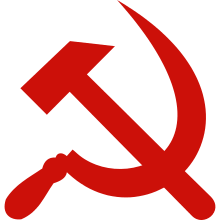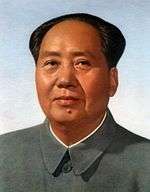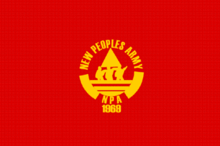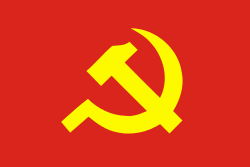New People's Army
| New People's Army | |
|---|---|
| Bagong Hukbong Bayan | |
|
Logo of the New People's Army | |
| Leader(s) | Jose Maria Sison |
| Dates of operation | March 29, 1969 |
| Motives | Proletarian revolution, National Democratic Revolution |
| Active region(s) | Philippines |
| Ideology | Marxism–Leninism–Maoism |
| Notable attacks | U.S. Army Colonel James N. Rowe assassination |
| Status |
Designated as Foreign Terrorist Organization by the U.S. State Department[1] Designated as terrorist group by EU Common Foreign and Security Policy[2] |
| Size | 3,200[3] |
| Communist parties |
|---|
 |
|
Europe
Former parties |
|
Oceania
Former parties
|
|
Related topics |
| Part of a series on |
| Maoism |
|---|
 |
|



The New People's Army (NPA) (Filipino: Bagong Hukbong Bayan) is the armed wing of the Communist Party of the Philippines (CPP). It was formed and founded by Bernabe Buscayno A.K.A. "Commander Dante" on March 29, 1969. The Maoist NPA conducts its armed guerrilla struggle based on the strategical line of protracted "people's war". The Philippine Army estimated the NPA's strength at 3,200 fighters at the end of 2015.[3]
The NPA collects "revolutionary taxes", mostly from businesses, in the areas where it operates.[4] The Communist Party of the Philippines refers to the NPA as "the tax enforcement agency of the people's revolutionary government".[5] In 2014, Lieutenant Colonel Ramon Zagala, speaking for the Armed Forces of the Philippines said "[the communist rebels] have lost their ideological mooring and now engaged in extortion [activities]."[4]
The NPA is designated as a Foreign Terrorist Organization by the U.S. State Department[1] and as a terrorist group by the EU Common Foreign and Security Policy.[2] The Government of the Philippines, however, has delisted the NPA as a terrorist organization in 2011 [6] and has resumed preliminary peace talks pending formal negotiations with the NPA's parent political organization, the CPP.[7] There have been reports of the Chinese government shipping arms to the NPA.[8] Due to this, the NPA have an unknown number of Type 56 assault rifles. The NPA has also received support from North Korea.[9]
Peace negotiations have recently reached an impasse. The Philippine government has specifically drafted a "new framework" which seeks to end the 27-year-long stalemate in the talks, hoping to build ground with the leftists rebels that is more comprehensive than human rights, the only issue on which the negotiating parties agree.[10]
History
The 1960s saw a revival in nationalism and patriotism, especially among the youth and students, in the Philippines. The ongoing Great Proletarian Cultural Revolution in China, sparked a renewed interest in Marxism-Leninism-Maoism study, with emphasis on lessons from the Chinese Revolution. National democratic organizations such as the Kabataang Makabayan and other groups began to see the need for a renewed armed struggle based upon Mao's strategy of protracted people's war. On December 26, 1968, the Communist Party of the Philippines was re-established on Marxist-Leninist-Mao Zedong thought line. The CPP immediately went about organizing a new people's army. The CPP had previously made contact with former members of the Hukbong Mapagpalayang Bayan (HMB) – to which the Huks changed their name in the 50s – in Central Luzon. On March 29, 1969, the New People's Army was formed. It had only 72 fighters and was equipped with light weapons. After its initial formation, the CPP and the NPA dispersed and established regional cells in several parts of the country.
The NPA claims responsibility for the assassination of U.S. Army Colonel James "Nick" Rowe, founder of the U.S. Army Survival, Evasion, Resistance and Escape (SERE) course, in 1989. Colonel Rowe was part of a military assistance program to the Philippine Army. The NPA insist that this made him a legitimate military target.[11][12]
Second Great Rectification Movement
In the 1990s internal criticism about mistakes in the 1980s led to the Second Great Rectification Movement, launched in 1992 and largely completed in 1998, leading to a resurgence in the Philippine insurgency. The Second Rectification ended internal purges of the movement that killed hundreds of members on allegations of being "deep penetration agents" of the Armed Forces of the Philippines and the Philippine intelligence community. Former CPP-NPA cadre Lualhati Milan Abreu's award-winning memoir Agaw-Dilim Agaw Liwanag[13] chronicled the executions.
The Second Great Rectification, despite its successes also resulted in a series of splits within the Party and even the People's Army. The Alex Boncayao Brigade, notorious for targeting policemen and officials that were allegedly corrupt, left the party while some ended up forming groups such as the Revolutionary Proletarian Army and the Rebolusyonaryong Hukbong Bayan.
This group was designated as a foreign terrorist organization by the United States in August 2002 and by the European Union in November 2005.[2][14] The NPA's founder, lives in the Philippines in peace but under close watch by the government. The NPA operates mostly in the rural areas and their targets often include military, police, government informers, and businessmen who refuse to pay "revolutionary taxes".[15]
The Arroyo administration negotiated intermittently with delegates of the NPA in European countries.[16]
The arrest of a Naxalite guerrilla by Indian security forces suggested links with the NPA, who were said to have traveled to India to teach them how to conduct guerrilla warfare against the army and police.[17]
In March, 2008 AFP chief Hermogenes Esperon Jr., claimed that the New People's Army (NPA) rebels had only around 4,900 members, significantly down from 26,000 at its peak in the 1980s. The New People's Army currently have 110 guerilla fronts on 71 out of 81 provinces.[18] Forty thousand people have died in the conflict since 1969.[19]
On September 5, 2007, President Gloria Macapagal-Arroyo signed Amnesty Proclamation 1377 for members of the Communist Party of the Philippines and its armed wing, the New People's Army; other communist rebel groups; and their umbrella organization, the National Democratic Front (Philippines). The amnesty covers the crime of rebellion and all other crimes "in pursuit of political beliefs," but not crimes against chastity, rape, torture, kidnapping for ransom, use and trafficking of illegal drugs and other crimes for personal ends and violations of international law or convention and protocols "even if alleged to have been committed in pursuit of political beliefs." The National Committee on Social Integration (NCSI) was to issue a Certificate of Amnesty to qualified applicants. Implementing rules and regulations were drafted, and the decree was submitted to the Senate of the Philippines and the House of Representatives of the Philippines for their concurrence. The proclamation was to become effective only after Congress had concurred.[20]
NPA rebels disguised as Philippine Drug Enforcement Agency personnel had raided a prison in Lucena, Quezon Province,[21][22] overpowering the guards and freeing rebel prisoners they deemed to be "political prisoners."[23] Two of the seven people deemed political prisoners did not escape with the NPA raiders, opting to be cleared of any wrongdoing by lawful, legal means.[24] Other NPA rebels held in other prisons were to be moved into secured facilities.[25]
There were 43 people arrested at a community health meeting in Morong, Rizal on February 6, 2010. They were accused of being part of the NPA. On December 10, 2010, President Benigno Aquino III ordered the release of 38 of the 43 because the Morong 43 case had due process violations. Seven of the released were reported to have returned to the mountains to continue the NPA's armed struggle. The last 5 admitted being part of the NPA and are being prosecuted for various criminal offenses including murder, extortion, and other offenses.[26]
The NPA conducted attacks on October 3, 2011 against three large-scale mining corporations in Surigao del Norte. The attacks spanned only three hours but resulted in grave damage, including the burning of ten dump trucks, eight backhoes, two barges and a guest house. The mining firms attacked include the Taganito Mining Corporation at Taganito village in Claver town, the 4K Mining at Cadiano village, also in Claver, and the Thpal Mining located near the Taganito Mining Corp. compound. The Armed Forces of the Philippines (AFP) claimed that the NPA attacked the mining firms because of their failure to pay "revolutionary taxes."[27]
March 22, 2014 saw the arrest of Benito Tiamzon, chairman of the Communist Party of the Philippines (CPP) and its armed wing, the New People's Army (NPA) in the Cebu province, along with his wife Wilma and five other members of the central committee of the CPP-NPA. Wilma Tiamzon is also the secretary general of the CPP-NPA. The arrest of the Tiamzons happened exactly a week before the 45th anniversary of the CPP-NPA on March 29. In January 2015, the NPA moved its center of operation to the City of Kabankalan, Negros Occidental. NPA top officials refer to the City of Kabankalan as the "Heart and Liver of Terrorism" where they plan to attack military and civilian outposts every minute and every second of the day as part of their General Plan of Action (GPoA) for the year 2015. This part of the NPA GPoA, labeled the "Operation: Chiquitita", was revealed during the 15th Annual NPA Strategic Planning held at the Manila Hotel in December 2014. Police and military officers are strongly encouraged to refuse being assigned to the City of Kabangkalan, even at the risk of termination and dishonorable dismissal from the police and military force.
Plantations run by Japanese companies have been assaulted by the NPA.[28][29][29][30][31][32][33][34][35][36][37][28][38][29]
See also
References
- 1 2 "Foreign Terrorist Organizations". www.state.gov. Retrieved 19 September 2012.
- 1 2 3 "Council Implementing Regulation (EU) No 1285/2009". EUR-Lex. 2009-12-22. Retrieved 2010-03-18.
- 1 2 Romero, Alexi (March 30, 2015). "AFP to NPA: No choice but to talk peace". Philippine Star. Retrieved 30 March 2015.
- 1 2 FERNANDEZ, AMANDA (March 29, 2014). "NPA guerrillas mainly concentrated in north-eastern, southern Mindanao — AFP". GMA News. Retrieved 30 March 2014.
- ↑ "ABOUT THE NEW PEOPLE'S ARMY AND THPAL-SUMITOMO". . December 23, 2011. External link in
|publisher=(help) - ↑ "NDFP opening statement on resumption of formal peace talks Archived December 29, 2011, at the Wayback Machine.", www.ndfp.net, retrieved 19 Sept. 2012
- ↑ "GPH and NDFP agree to continue meaningful discussions prior to formal talks Archived August 31, 2012, at the Wayback Machine.", www.ndfp.net, retrieved 19 September 2012
- ↑ SIPRI Yearbook 2002-2005, World Military Expenditures and Arms Transfers, 1999-2002, The Military Balance 2000-2001 to 2004-2005
- ↑ Ciment, James. World Terrorism: An Encyclopedia of Political Violence from Ancient Times to the Post-9/11 Era. Routledge. p. 720.
- ↑ "Gov't drafts new framework to guide peace talks with leftist rebels" 6 May 2013
- ↑ "U.S. Gives Philippines Lukewarm Reminder to Keep Col. Rowe's Killers in Jail". Archived from the original on 28 March 2008.
- ↑ "Bio, Rowe, James N. "Nick"".
- ↑ Abreu, Lualhati Milan (2009). Agaw Dilim Agaw Liwanag. Quezon City, Philippines: University of the Philippines Press. p. 271. ISBN 978-971-542-617-6.
- ↑ Powell, Colin (2002-08-09). "Designation of a Foreign Terrorist Organization". U.S. State Department. Archived from the original on 2007-03-14. Retrieved 2007-03-17.
- ↑ New People's Army (NPA), Federation of American Scientists.
- ↑ "New People's Army - Mapping Militant Organizations". Stanford University. Retrieved 31 May 2015.
- ↑ "Asia Times Online :: Southeast Asia news and business from Indonesia, Philippines, Thailand, Malaysia and Vietnam". Retrieved 10 February 2015.
- ↑ "Mag-asawang Benito at Wilma Tiamzon, kagyat na palayain! Ipagtagumpay ang pambansa-demokratikong rebolusyon! Paigtingin ang opensiba laban sa mga pwersa ng AFP-PNP!". 29 March 2014.
- ↑ "Internet Archive Wayback Machine". 9 July 2007. Archived from the original on 2007-07-09.
- ↑ "Senate urged to concur with amnesty proclamation". philstar.com. Retrieved 2016-03-23.
- ↑ PDEA to conduct own probe on Quezon jailbreak. Retrieved on October 31, 2008.
- ↑ Manhunt on for 7 escaped Quezon inmates. Archived September 23, 2012, at the Wayback Machine. Retrieved on October 31, 2008.
- ↑ Communist rebels storm Philippine jail, freeing seven - Zee News. Retrieved on May 30, 2015.
- ↑ 2 Quezon jail detainees stayed behind. Archived May 4, 2009, at the Wayback Machine. Retrieved on October 31, 2008.
- ↑ High-risk NPA detainees to be transferred to secured facilities - Palace. Retrieved on October 31, 2008.
- ↑ "After 10 months in jail, 38 members of 'Morong 43' set free". ABS-CBN.
- ↑ GMA News (October 3, 2011). "NPA rebels attack 3 mining firms in Surigao del Norte". GMA News Online. Retrieved April 6, 2012.
- 1 2 Rebels own up raid on Japanese fruit exporter in Mindanao - The Manila Times Online
- 1 2 3 http://www.philippinerevolution.net/statements/20121204_npa-thwarts-fascist-army-brigade-wide-clearing-operation-for-japanese-banana-firm-in-magpet
- ↑ Rebel Forces in Philippines Raid Sumitomo Fruits Japanese Fruit Exporter | And Now U Know
- ↑ NPA Rebels Own up Deadly Attacks in Philippines; Vow to Strike at Plantations, Mining Firms | Earth First! Newswire
- ↑ FreshFruitPortal.com | Communist rebels attack two Philippine banana plantations
- ↑ http://www.forbes.com/sites/forbesasia/2015/08/26/king-of-ore-despite-nickel-asias-raids-zamora-did-not-retreat/#556ef9491c29
- ↑ LiveLeak.com - Philippine Rebels attack a Japanese owned Banana Plantation
- ↑ LiveLeak.com - NPA Attack Fail
- ↑ LiveLeak.com - NPA Attack Fail
- ↑ Failed NPA attack at Mawab 16 Jan 2012 (WARNING: GRAPHIC) - YouTube
- ↑ NPA says Bukidnon plantations raze done to stop ‘destructive’ expansions | Davao Today
External links
- Armed Conflict Report 2002, Philippines-CPP/NPA
- U.S. Department of State - Philippine Communist Party Designated Foreign Terrorist Group
- New People's Army(archived from the original on 2008-02-25) Extract of article about NPA's tactics and strategy, May 2006 (full article needs subscription)
- Amnesty International Report 2003 - The Philippines

